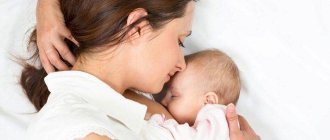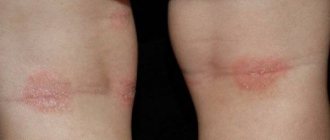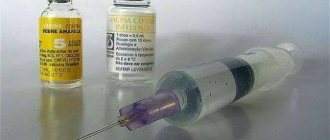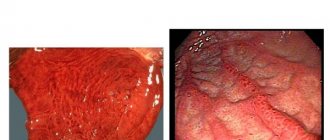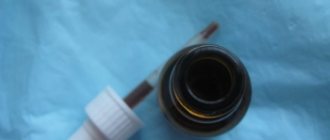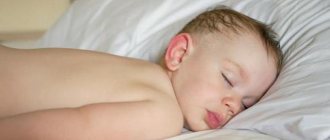Causes of eczema in children
Eczema occurs against the background of a combination of negative factors, which are divided into internal and external.
Internal factors:
- Chronic or acute diseases of internal organs.
- Disturbance in the functioning of the endocrine or nervous system.
- Bacterial or viral infections.
- Reduced immunity.
- Hereditary factor.
- Violation of the rules of the first complementary feeding or incorrectly selected artificial nutrition.
- Insufficient child hygiene, improper skin care.
- Hormonal imbalance – during puberty in adolescents.
External factors:
- Mechanical disorders of the skin - wounds/abrasions/diaper rash/wearing tight clothing or synthetic fabrics.
- Contact with chemicals (household chemicals); use of hygiene products containing aggressive components; abuse of antibacterial agents.
- Long-term use of potent medications.
- Burns/frostbite/prolonged exposure to direct sunlight.
- Constant contact with the source of the allergy.
Many experts believe that a complicated pregnancy can cause eczema in the child, as well as the presence of serious diseases in the mother - diabetes, vascular and heart diseases, etc.
The presence of helminths does not cause the development of the disease, but increases the risk of eczema.
Find out more
Prevention
To prevent the development of eczema and prevent its relapses, certain recommendations should be followed:
- Even during pregnancy, the expectant mother needs to carefully monitor her diet and not overuse food that causes allergies. The same rule applies during breastfeeding. It is especially important to observe it for those who have a hereditary predisposition to allergies and skin diseases.
- The baby's clothes and shoes should be comfortable, made from natural fabrics and leather.
- When carrying out water procedures, it is best to use special hypoallergenic products. You can add chamomile or chamomile infusion to the bath, this will soothe irritation.
- It is important to provide the child with comfortable living conditions. Feeding and walking should be on schedule. It is advisable to do a daily wet cleaning of the room and ventilate the room.
Since it is much easier to treat eczema at an early stage, you should not wait for consequences. If polymorphic rashes appear, itching, swelling and redness develop, you should immediately consult a doctor.
Types of eczema in children
Several types of eczema have been identified, they vary depending on the causes of occurrence, the location of the lesions and the symptoms of the disease.
- True
- Seborrheic
- Viral
- Bacterial
- Atopic
- Kaposi
- Coin-shaped
The most common among children is idiopathic (true), occurring in newborns (from 2 months). This form is characterized by a chronic course, and exacerbations in the autumn-spring period, when the immunity of children is threatened.
You can see what different forms of eczema look like in infants and older children in the photo section.
Causes and mechanisms of development
This is an allergic disease with a hereditary predisposition. It is not the pathology itself that is transmitted from parents, but the tendency to develop it. Often in the child’s family there are patients with bronchial asthma, hay fever, drug allergies, urticaria and other allergic diseases.
Is eczema transmitted from mother to child?
If one of the parents is sick, the probability of a predisposition in the child is about 40%. If both parents have the pathology, this risk is 75%, and the disease occurs in the first year of life and is characterized by a severe course.
Direct causes of eczema:
- poor nutrition of the baby;
- diseases of the digestive system (gastroenteritis, hepatitis, dysbacteriosis, disruption of the pancreas);
- taking medications;
- viral infections.
The disease most often occurs in children with exudative diathesis, a metabolic disorder that increases the skin's susceptibility to inflammatory processes. Allergic diathesis also matters. A predisposition to allergies is formed in the prenatal period with the mother’s excessive consumption of food allergens (honey, chocolate, strawberries, and so on). In the future, eczema in a baby can be triggered by the mother consuming a small amount of an allergenic product, for example, one chocolate candy.
The likelihood of a child developing eczema increases if the pregnancy was accompanied by severe vomiting or the threat of miscarriage.
One of the provoking factors is immune deficiency, which is often inherited from the mother. The resulting chronic infectious foci lead to allergization of the child's body to bacterial antigens. Developing eczema is very difficult to treat.
Functional disorders of nervous and hormonal regulation play a certain role in pathogenesis. They can develop even before birth if the mother experienced severe stress during pregnancy.
Causes associated with poor nutrition:
- early complementary feeding using cow's milk;
- confectionery, sweet pastries, condensed milk;
- consumption of milk formula that has been stored for a long time;
- semolina porridge with sugar and milk;
- rich meat and fish broths;
- citrus fruits, chocolate and other food allergens;
- early artificial feeding.
Concomitant infections that cause eczema in children:
- streptoderma;
- candidiasis;
- ascariasis;
- enterobiasis (pinworms);
- tuberculosis;
- ARVI;
- microbes that multiply in the so-called milk crusts, which must be removed in a timely manner.
Other contact allergens:
- house dust;
- down and feather pillows;
- animal hair;
- pollen;
- synthetic fabrics.
Thus, the causes and mechanism of development of childhood eczema are almost identical to atopic dermatitis.
Symptoms of eczema in children
Eczema often appears on the cheeks (so it can easily be confused with a simple food allergy) and on the scalp, but can affect any part of the body, including the arms, legs and buttocks, and in advanced cases can be localized throughout the body. But each form has its own clinical picture:
- True - at the very beginning of the disease, scarlet or pink bubbles of different sizes may appear. The first rashes, which have cloudy contents, are localized in the face area, later moving to the folds of the arms and legs. After opening on their own, these areas dry out, forming an eroded area covered with crusts. In cases of teenage eczema caused by hormonal changes in the body, the former sites of localization of lesions may acquire bluish or purple shades, the eczema itself turns into a weeping form, and swelling of the affected skin areas is noted. Diseases in this form can go away on their own, and after a while they can arise again.
- Seborrheic - the exact reason why the development of this form begins is not known. Characteristic is the appearance of plaques on the scalp, which have a yellowish tint and are covered with scales, hence the flaking similar to dandruff. Such plaques can occur on different segments of the skin, but are rare. On skin where there is hair, the formation of plaques is due to a large number of ducts of the sebaceous glands. The lesions protrude above the level of healthy skin and are noticeable when touched.
- Viral - as the name implies, the development of the disease is caused by pathogenic viruses - influenza, chickenpox, rubella and herpes. Rashes in this form are localized on absolutely any segment of the skin - face, torso, limbs. Along with dermatological rashes, there is swelling of the skin, which is susceptible to rashes. The rash has a red tint and may be accompanied by itching.
- Bacterial – the second name for microbial, is caused by pathogenic microorganisms. The occurrence of this type is preceded by a bacterial infection. The symptoms of the disease are similar to those of viral eczema.
- Atopic – occurs against the background of constant contact with an allergen. The course of the atopic form does not differ from other types. It begins with the skin of the face and head, has a red tint, and if the disease is ignored, the development of weeping eczema is possible.
- Kaposi - the cause of this form is recognized to be the herpes virus type 8. It differs from other forms in the severity of its course, especially at an early age (infants and preschoolers) - there is an increase in body temperature, enlarged lymph nodes, and general malaise. The rash can be located on any segments of the skin, forming eroded areas as the disease progresses. Ignoring the disease in this case can provoke negative consequences for the child’s health.
- Coin-shaped - this form is rare in infants; the development of a coin-shaped form is often characteristic of older children. Oval or round plaques appear on the child’s body, most often on the back, buttocks or legs, which give the basis for the name. The plaques are flaky, they are covered with several layers of scales, and are red in color.
We looked at the most common forms of eczema; there are also several rare forms - dyshidrotic, dry, mycotic (fungal), herpetic.
In addition to the forms of eczema, there are forms according to the course of the disease - acute or chronic. The stages of occurrence are also highlighted:
- Erythematous – the initial stage, hyperemia and swelling of the skin occurs.
- Blistering is the next stage; the rash area can reach three centimeters in diameter.
- Weeping - not typical for each form, but when the weeping stage occurs, the bubbles open, forming weeping areas.
- Crusty - wet areas dry out, forming flaky crusts.
- Chronic – areas of the skin prone to rashes become thicker and peel.
In addition to rashes, plaque formation and peeling, the following signs of eczema in children are identified: burning and severe itching, loss of appetite, general deterioration in physical condition, irritability, and sleep disturbances.
Localization of rashes
In children, a characteristic rash most often occurs on the scalp and face (in particular, the cheeks). Also, the rash often affects the skin of the extremities (arms and legs), groin area and buttocks.
Over time, if the necessary therapeutic measures are not taken, the pathology progresses and the rash spreads to other areas of the skin.
In severe cases of the disease, rashes can cover the child’s entire body.
Treatment of eczema in children
Before starting treatment for eczema, it is important to establish an accurate diagnosis, because eczema rash may have similar symptoms to other dermatological diseases - herpes rash, diathesis, allergic manifestations, urticaria, lichen, etc.
In addition to separating eczema from other diseases, it is important to establish the cause of the disease in order to prescribe effective treatment. For diagnostic purposes the following is prescribed:
- General blood test - to identify inflammatory processes in the body (the ESR indicator can indicate this);
- Examination of separated particles of the dermis under a microscope - to exclude lichen and identify or exclude the presence of fungus and other viruses;
- Allergy tests – in cases of atopic eczema, to identify and eliminate the source of the allergy;
- Histological studies – to identify diseases of an autoimmune nature.
Based on the diagnoses received and taking into account the age and characteristics of the body, the doctor prescribes treatment. Treatment of eczema involves complex therapy:
- Diet – nutrition is adjusted, diet changes. For bottle-fed children, a replacement formula is required; for older children, the exclusion of foods that can trigger allergies.
- Sedatives – to normalize sleep if necessary.
- Antihistamines - to relieve discomfort (itching, burning).
- Anti-inflammatory - tablets or ointments to relieve swelling of the skin and improve general condition.
- Vitamin complexes and/or immunomodulators - to increase or maintain immunity levels.
- Antibiotics or antivirals - in cases of bacterial or viral etiology.
For rapid tissue regeneration, physiotherapy can be prescribed - it is often used for treatment, especially in young children, when many medications cannot be prescribed due to age.
With eczema, it is very important to pay attention to hygiene - the child must be bathed twice a day, using only children's hypoallergenic products, not only detergents, but also skin care products (oils, powders, etc.).
In the presence of wounds and abrasions, antiseptic treatment is necessary to prevent secondary infections.
The prescription of medications itself is unacceptable; the dermatologist selects treatment individually, based on the tests obtained.
Therapy
Before starting treatment, the doctor must find out the cause of eczema in the child. After this, the influence of the stimulus should be eliminated:
- If the baby is breastfed, then the mother is prescribed a diet with restrictions on certain types of foods. For bottle-fed children, it is proposed to review the formulas consumed and, if necessary, switch to other options.
- It is important for preschoolers to stop eating allergenic foods. Exclude fatty broths, chocolate, citrus fruits, spices, and spicy dishes from the menu.
- The baby's clothes should consist of natural fabrics with a minimum number of seams to prevent irritation. Do not wear tight clothing.
- It is imperative to sanitize infectious foci, and if a helminthic infestation is suspected, deworming must be carried out.
Medicines
For treatment, local agents and systemic drugs should be used in combination.
- For weeping eczema, it is recommended to apply lotions several times a day with Burov's liquid or boric acid solution.
- After the affected areas have dried, you should use Skin-Cap, Eplan, boron-naphthalan ointments.
- The most commonly prescribed steroid drugs are Prednisolone ointment or Flucinar. They combine well with non-hormonal drugs.
The selection of medications for internal use is carried out taking into account the age of the baby, the type of eczematous rash and the severity of the process. The doctor takes into account the characteristics of the constitution, the degree of impairment of the immune response, the state of the nervous system, and the presence of endocrine abnormalities.
Groups of drugs that are used for childhood eczema:
- Sedatives. They help calm the child, improve his general condition and normalize sleep. Light remedies are used for this purpose (valerian tablets, Tenoten), but sometimes you have to resort to potent drugs - Meprobamate, Andaxin. VSD and neurotic disorders are relieved with Amizil or Tazepam.
- Antihistamines. They are selected according to age and given in a short course (about 10 days). Usually in this case Diphenhydramine, Tavegil, Suprastin, Fenkarol are prescribed.
- Anti-inflammatory. A 1% sodium salicylate solution is well suited for this purpose.
- Desensitizing therapy. Sodium thiosulfate is used for this; it is used to purify the blood.
- Products containing calcium. Calcium gluconate or glycerophosphate is combined with antiallergic medications.
- The addition of a purulent infection is an indication for the use of antibacterial agents. Broad-spectrum drugs (penicillins or macrolides) are usually recommended. Such treatment is not mandatory and is used only when complications develop.
- A pronounced process requires the use of systemic glucocorticoid therapy. They are prescribed for internal use in a short course (Dexamethasone, Prednisolone tablets).
To relieve especially severe forms, the use of hemosorption and plasmapheresis is sometimes practiced..
Traditional treatment
The use of natural ingredients is effective only at the initial stage of disease development.
- Kalanchoe juice is useful for external use. Soak sterile gauze with fresh juice and apply to damaged skin for five minutes. Repeat daily until signs of improvement appear.
- Grape pulp helps with eczema. The juice is squeezed out of the berries, and the remaining mass is placed in a bandage and applied for two hours. The course is 10 days, after which you should take a break.
- Infusions of string, motherwort, and chamomile are suitable for washing rashes and healing baths. To prepare, pour 3 tablespoons of the selected plant material into a liter of boiling water, keep in a water bath for 5-7 minutes, filter after cooling.
Traditional methods can have not only healing, but also negative effects, so you should not use home remedies without consulting a dermatologist or pediatrician.
Treatment of eczema in children with folk remedies
There are many traditional medicine recipes for the treatment of eczema in children, but self-medication is unacceptable, even in relation to herbal medicine, because ignorance of the properties of some components can increase discomfort and harm the child’s health.
Often, alternative medicine recommends using herbs to make decoctions that should be added to water while taking a bath.
Common herbs that can be used are string, chamomile, calendula, hawthorn, motherwort, etc.
What is Seborrheic Eczema?
Seborrheic eczema (dermatitis) is a pathological process on the surface of the skin in the area where the sebaceous glands are concentrated, characterized by the appearance of scab-like plaques and weeping areas.
The rash is accompanied by periodic itching. Seborrheic eczema is a disease characterized by impaired functioning of the sebaceous glands. Rough, scaly patches on a newborn's scalp can be concerning for parents, but it's usually nothing to worry about. They are most likely caused by a harmless condition called seborrheic crown.
Alternative medicine to help with seborrhea symptoms
Drug treatment of seborrheic eczema in children is not the only way to overcome the disease. You can speed up the onset of recovery and reduce the severity of symptoms using unconventional methods. Therapy with folk remedies often acts as an auxiliary, enhancing and consolidating the therapeutic effect of the use of potent pharmaceutical drugs. Homemade recipes, which have long been used to treat skin diseases, help strengthen local immunity and start the process of regeneration of the affected epidermis.
Traditional treatment of seborrheic eczema in a child involves the use of the following remedies:
- Herbal decoction for washing and rinsing hair. For seborrheic dermatosis, components are selected based on the severity of their antiseptic and antifungal properties. St. John's wort, string and calendula have virtually no contraindications, with the exception of individual intolerance. Taking 1 tbsp. l. each medicinal plant, mix everything and pour boiling water, put on fire and bring to a boil. The resulting decoction is filtered, diluted with cold water and used as directed every day when washing and after washing your hair.
- Oil solutions. For preparation, tea tree oil, castor oil, calendula tincture or ethyl alcohol are suitable. Prepare in a ratio of 10 parts oil composition to 1 part alcohol composition. The resulting composition is applied with a cotton sponge to the affected areas of the skin in the morning and evening.
- Homemade ointment for seborrheic eczema for children made from burdock and garlic. To prepare the composition you will need a paste of plant leaves and garlic cloves. Apply the mixture to eczematous lesions for 10-15 minutes, after which the product must be washed off with running water.
- Decoction of oak bark with honey. For seborrheic eczema in children, this remedy is used only if one is absolutely sure that there is no allergic reaction to the bee product. Add 2 tsp to the pre-prepared warm broth. honey, after which the mixture is thoroughly rubbed into the epidermis. The composition helps get rid of itching, dandruff and reduce inflammation.
